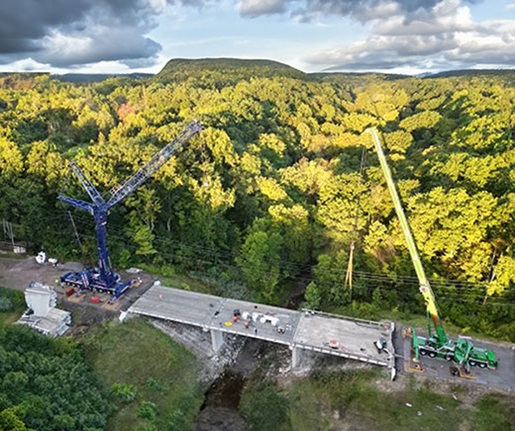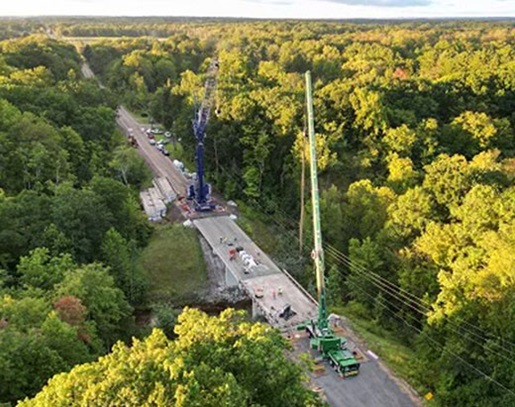
When ALL Erection & Crane Rental, flagship yard of the ALL Family of Companies, purchased a couple of Liebherr all terrain cranes in recent years, the branch requested some unusual paint jobs. For a new Liebherr LTM 1650-8.1, the color was cobalt blue. For a new Liebherr LTM 1300-6.3, the color was green. Around the yard, they’ve earned the respective nicknames the Blue Beast and the Hulk. And, just like a superhero team-up from the golden age of comics, these two titans finally met on a single job site.
The location of this historic meeting was Northeast Ohio along a stretch of State Route 534 in Rock Creek. A three-span bridge was being replaced with another three-span concrete box beam bridge.
There was a short window to complete the work, so ALL’s customer, A.P. O’Horo Company, the general contractors on the project, determined that single-picking each span would be more efficient than dual-picking the center span. So, yes, while the Blue Beast and the Hulk did in fact meet on the job … they didn’t perform a lift together.
Instead, the Blue Beast set up one side and was responsible for spans 1 and 2, while the smaller Hulk set up on the other abutment and handled span 3. The Blue Beast was on the job site for about a week and a half, while the Hulk made a guest appearance for just a few days to handle the third span.
The Blue Beast (Liebherr LTM 1650-8.1) was configured with the longer T5 main boom, 115 feet of luffing jib, and 341,700 pounds of counterweight at a 135-foot lift radius. Each bridge span measured 75 feet long and weighed 77,000 pounds.
The Hulk (Liebherr LTM 1300-6.3) used 146 feet of main boom at a 60-foot lift radius and had 195,000 pounds of counterweight.
The Blue Beast was configured with the luffing jib because it provides a capacity boost needed to single-pick the center span. “Although luffing jibs are typically used for ‘up and out’ lifting purposes like you often see in urban construction, like setting a large air conditioner on top of a skyscraper, we’ve discovered, with these larger Liebherr ATs, that going with a short luffing jib dramatically increases lift capacity,” said Brian Meek, equipment specialist with ALL. “In this instance, at a 135-foot radius, with the luffing jib our capacity was 93,000 pounds. Without it, it would have been only 73,000 pounds.”
This solution won’t work for all job sites, because sometimes space limitations won’t allow for the extra room needed to build the boom. “You do need a straight laydown area to build the jib,” said Meek. “So you can’t use it on every bridge, but it is a nice option to have for the right circumstances.”
This was the first bridge job for the Hulk. “This is a highly versatile crane,” said Meek. “It has a 295-foot main boom and four jib options. The day before this lift, it was outfitted with full boom and full jib for some ‘up and out’ work, so it has that reach but also has an excellent chart close-up.”
The three-axle dolly for its boom also comes in handy. “Often in this 300-ton weight class of cranes, the boom has to be removed,” added Meek. “But here we can pull up to the job site, start stacking counterweight and get right to work.”
Meek gives the team at A.P. O’Horo credit for coming up with the creative usage of both cranes. “In addition to the fast schedule, it was a tight job site with obstructions on one side and a ravine on the other side. Planning was key. And using a larger crane to single-pick the first and middle sections, and a smaller AT to handle the third span, was absolutely the right call for this situation.”

